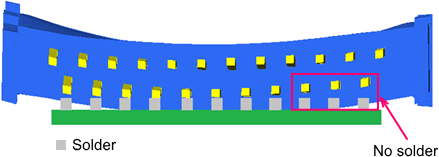Home > Technical Support > Product Design
Using CAE to Forecast Deformation During the Reflow Process
| Design That Reduces Thermal Deformation: Using CAE to Forecast Deformation During the Reflow Process |
|---|
| 1. Introduction |
In the market for connectors, mobile products such as smartphones have become prevalent in emerging nations over the last few years. As these devices have also been getting smaller and more sophisticated, the use of connectors has been increasing, and there is demand for them to be made even smaller. At the same time, the spread of electronic vehicles has resulted in connectors being used more often as car parts. People also rely on connectors used as car parts to be durable and safe enough to withstand harsh conditions. Since connectors are expected to deliver such high levels of precision, liquid crystalline polymer (LCP) is now being selected more and more frequently. LCP is the collective name of thermoplastic aromatic polyesters that show liquid crystalline properties during melting. They are characterized by having rigid molecular structures that are hard to bend, and by having very little of the molecular interlocking that is particular to polymeric substances. For this reason, they deliver excellent dimensional accuracy and heat resistance, and are able to handle high reflow temperatures in the solder bonding process when manufacturing connector parts. However, resin parts expand considerably in the high temperature conditions of reflow processes even if LCP is used which may have an effect on the flatness of the products. Since heat deformation in the reflow process causes poor bonding due to solder not being applied to the metal terminals, when designing the connectors it is important to find ways to reduce heat deformation. As connectors have become smaller and thinner in recent years, heat deformation has had an increasingly larger impact on the precision of molded articles. This is why Polyplastics used CAE (computer-aided engineering) and began considering design stage deformation forecasting for molded articles in the reflow process. Here we will provide an outline on this subject. |
 |
| Figure 1 : Solder not applied to metal terminals due
to variation in flatness of terminals |
|---|
2. Observing deformation behavior during heating and cooling |
|
2.1. Observation methodology |
|
We used a sample in the shape shown in Figure 2 to take measurements in order to understand the characteristics of heat deformation during the reflow process. We used an instrument (Figure 3) that is capable of "In-situ observation" in high-temperature conditions (SP5000-DS made by Sanyoseiko Co., Ltd.). In order to study the effect of thermal history, we also took measurements of cases in which samples that had been given heat treatment were given heat treatment again. |
|
||||||
18th July 2018 |

